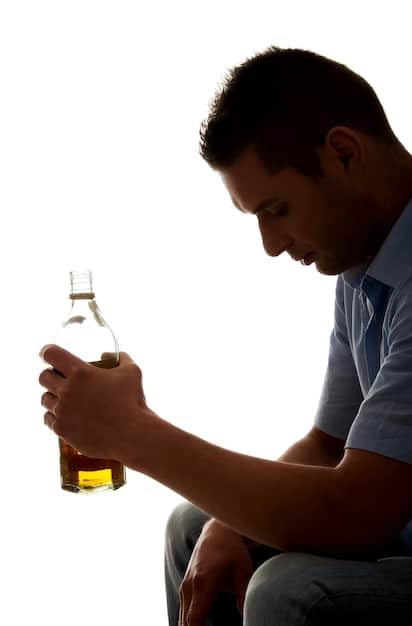Substance Abuse and Men’s Mental Health: Breaking the Cycle

The intricate relationship between substance abuse and men’s mental health is a critical public health concern, where untreated mental health conditions often fuel addiction, creating a complex cycle that demands integrated, gender-specific approaches for effective intervention and lasting recovery.
The intersection of substance abuse and mental health in men presents a landscape often obscured by societal expectations and deeply ingrained stereotypes. When discussing Substance Abuse and Men’s Mental Health: Breaking the Cycle of Addiction, it becomes clear that many men face unique challenges in seeking help, driven by pressures to appear strong and self-sufficient. This article explores the complex interplay between these two critical areas, offering insights into how to foster recovery and build healthier lives.
The Hidden Epidemic: Understanding Addiction in Men
Addiction in men is far more prevalent than often discussed, frequently masquerading as coping mechanisms for underlying emotional pain or stress. Society’s traditional masculine ideals, which often discourage the expression of vulnerability or the acknowledgment of mental health struggles, contribute significantly to this hidden epidemic. Many men resort to substances as a means to self-medicate feelings of anxiety, depression, or unaddressed trauma, creating a dangerous feedback loop.
The journey into substance abuse for men often begins subtly, almost imperceptibly, as seemingly innocuous ways to unwind or manage pressure build over time. These initial explorations into substance use can quickly escalate into full-blown addiction when left unchecked, particularly in environments that normalize or even celebrate heavy drinking or drug use. The gradual dependence on these substances then creates a reinforcing cycle, where the temporary relief they offer further masks the true extent of the underlying issues.
Societal Pressures and Their Impact
From a young age, many men are taught to suppress emotions like sadness or fear, adopting a stoic demeanor. This conditioning can be detrimental when facing mental health challenges, as it discourages open communication and professional help-seeking. Instead, substances become a perceived solution, a silent confidante to personal struggles.
- Stigma against vulnerability: The deeply ingrained belief that showing emotion is a sign of weakness deters men from disclosing mental health issues.
- “Man up” mentality: The pervasive societal message that men should handle their problems independently, without external assistance.
- Provider role stress: Economic and familial pressures can lead to chronic stress, which is often managed through substance use rather than healthy coping strategies.
The societal narrative often paints a picture of resilience and self-reliance as inherently masculine traits. While these qualities can be positive, they become maladaptive when they prevent men from acknowledging their struggles and seeking necessary support. This internal conflict between perceived strength and actual vulnerability can fuel a destructive cycle, trapping men in patterns of substance abuse. The fear of judgment or the loss of social standing can be powerful deterrents, keeping men from reaching out even when they recognize the severity of their situation.
Ultimately, the hidden epidemic of addiction among men is a complex issue rooted in a combination of biological, psychological, and sociological factors. Addressing it requires a multifaceted approach that not only treats the addiction itself but also dismantles the societal constructs that perpetuate silence and suffering. By encouraging a culture of openness and support, and by providing accessible, destigmatized resources, we can begin to break the cycle and build paths to sustainable recovery.
The Intertwined Nature: Mental Health Conditions and Addiction
It’s rarely a simple case of “addiction” or “mental illness”; more often, they coexist, each exacerbating the other. This phenomenon, known as co-occurring disorders or dual diagnosis, is particularly prevalent in men. Anxiety, depression, PTSD, and even undiagnosed neurodevelopmental disorders can all serve as precursors or amplifiers of substance use, making effective treatment significantly more intricate.
The relationship between mental health and substance abuse is a two-way street. Mental health conditions can increase the risk of substance abuse as individuals attempt to self-medicate painful emotions or symptoms. Conversely, substance abuse can worsen existing mental health disorders or even trigger new ones by altering brain chemistry and disrupting emotional regulation. This creates a challenging cycle, where addressing one without the other often proves ineffective, leading to relapse and prolonged suffering.
Common Co-Occurring Disorders
Understanding which mental health conditions frequently accompany substance abuse is crucial for proper diagnosis and treatment. For men, certain disorders show a higher correlation, indicating specific vulnerabilities that need tailored intervention strategies.

- Depression: Often masked by irritability or anger in men, depression can lead to self-medication with alcohol or drugs for temporary relief.
- Anxiety Disorders: Chronic stress, panic attacks, or generalized anxiety can push men towards substances to calm their nerves or escape overwhelming thoughts.
- Trauma (PTSD): Unresolved traumatic experiences, whether from military service, abuse, or other life events, are significant drivers of substance use to numb the pain.
- ADHD and Bipolar Disorder: These conditions, when undiagnosed or improperly managed, can lead to individuals seeking self-medication for symptom control, often progressing to dependency.
The complexities of co-occurring disorders necessitate an integrated treatment approach. This means addressing both the substance abuse and the mental health condition simultaneously within the same therapeutic framework. Treating only one aspect, such as focusing solely on addiction without acknowledging underlying depression, often sets the stage for relapse. Men need and deserve comprehensive care that recognizes the interconnectedness of their struggles, providing them with the tools and support to heal holistically.
Moreover, the shame associated with both mental illness and addiction can prevent men from seeking help. This double stigma creates a formidable barrier, reinforcing the cycle of silence and suffering. Breaking this cycle requires not only robust treatment programs but also broader societal shifts that normalize help-seeking and de-stigmatize these conditions. By fostering an environment of acceptance and understanding, more men may feel empowered to step forward and access the care they desperately need.
The Cycle of Addiction: Triggers, Relapse, and Recovery
The cycle of addiction is a relentless loop, characterized by triggers, the act of using, subsequent guilt or shame, and then a return to avoidance through substance use. For men, this cycle is particularly insidious because it often thrives in secrecy, fueled by the reluctance to admit vulnerability. Understanding its mechanics is the first step toward effective intervention and sustained recovery.
The initial trigger can be anything from stress at work, relationship problems, to memories of past trauma. These triggers amplify negative emotions, which men might feel unable to process in socially accepted ways. Substances then become a perceived escape, a temporary reprieve from discomfort. However, this relief is fleeting, soon replaced by deeper feelings of shame, isolation, and regret, which then become new triggers, restarting the cycle.
Identifying and Managing Triggers
Effective recovery hinges on the ability to identify personal triggers and develop healthy coping mechanisms. Triggers can be internal (emotions like stress, loneliness, anger) or external (people, places, things associated with past use). For men, particularly, external triggers that reinforce traditional male roles, such as social gatherings centered around heavy drinking or competitive environments, can be powerful.
The process of identifying triggers is deeply personal and requires introspection, often facilitated by therapy. Once identified, strategies for managing them range from avoidance, if possible, to developing robust resilience skills. This might include learning to articulate emotions, engaging in stress-reducing activities, or building a supportive network that understands the recovery journey.
- Stress and Work Pressure: High-stress professional environments can lead to substance use as a way to decompress or cope with performance demands.
- Relationship Issues: Conflict with partners, family, or friends often leads to emotional distress that men may try to numb with substances.
- Social Isolation: Lack of meaningful connections or feelings of loneliness can serve as significant triggers, especially if social interaction has historically revolved around using.
Relapse, while often disheartening, is a common part of the recovery process rather than a sign of failure. It provides vital information about unmet needs or unaddressed triggers. For men, the shame associated with relapse can be particularly strong, sometimes leading to a complete abandonment of recovery efforts. Therefore, fostering an environment of non-judgmental support and viewing relapse as a learning opportunity is crucial.
Breaking the cycle of addiction involves not just abstinence but a fundamental shift in coping mechanisms, self-perception, and social engagement. It requires courage to confront underlying issues and vulnerability to seek and accept help. For men, this means challenging deeply ingrained norms about masculinity and embracing a more holistic definition of strength—one that includes emotional resilience and a willingness to heal.
Navigating the Path to Recovery: Tailored Approaches for Men
Recovery is not a one-size-fits-all journey, particularly when considering the unique needs of men struggling with substance abuse and mental health issues. Tailored approaches are essential, recognizing that traditional therapy models might not always resonate with masculine communication styles or emotional processing. Successful recovery often involves integrating various therapeutic modalities, fostering supportive communities, and addressing the specific societal pressures men face.
A crucial aspect of effective treatment for men involves creating spaces where they feel safe to express vulnerabilities without fear of judgment. This might mean male-only groups, therapists who understand gender-specific issues, or treatment settings that emphasize practical, solution-focused strategies alongside emotional work. The goal is to build trust and empower men to confront their issues directly, rather than resorting to avoidance.
Key Components of Effective Treatment
Comprehensive treatment plans for men typically incorporate a blend of therapies designed to address both the addiction and the underlying mental health conditions. These components often focus on behavioral changes, emotional regulation, and building a robust support system.

- Integrated Treatment for Co-occurring Disorders: Simultaneous treatment of addiction and mental health conditions ensures that underlying issues fueling substance use are addressed.
- Cognitive Behavioral Therapy (CBT): Helps men identify and change negative thought patterns and behaviors that contribute to substance abuse.
- Trauma-Informed Care: Essential for men with a history of trauma, this approach recognizes the profound impact of past experiences on current behavior and emotional well-being.
- Support Groups (e.g., AA, NA): Provide a safe space for men to share experiences, build community, and receive peer support, reducing feelings of isolation.
- Family Therapy: Educates family members and helps heal damaged relationships, fostering a supportive environment crucial for long-term recovery.
- Mindfulness and Stress Reduction Techniques: Equips men with practical tools to manage stress, anxiety, and cravings without resorting to substances.
Beyond formal therapies, fostering healthy lifestyle changes plays a significant role. This includes promoting regular physical activity, balanced nutrition, sufficient sleep, and engaging in hobbies that provide a sense of purpose and fulfillment. These activities not only improve overall well-being but also serve as healthy outlets for stress and emotional management, reducing the likelihood of relapse.
Ultimately, a successful path to recovery for men is multifaceted, dynamic, and deeply personal. It requires dismantling the societal expectations that often hinder men from seeking help, providing tailored and integrated treatment options, and building a supportive community that champions vulnerability and resilience. By embracing these holistic approaches, we can help men not only overcome addiction but also achieve lasting mental wellness and a profound sense of self.
Building Resilience: Strategies for Long-Term Wellness
Achieving sobriety is a monumental first step, but true recovery is about building lasting resilience—the capacity to bounce back from adversity and maintain mental well-being in the face of life’s challenges. For men, this often means developing emotional intelligence, cultivating healthy relationships, and engaging in activities that provide purpose and meaning beyond substance use. It’s a continuous process of growth and adaptation.
Resilience is not an innate trait; it’s a skill set that can be developed and strengthened over time. For men, this involves learning to navigate internal and external pressures without resorting to harmful coping mechanisms. It means replacing destructive habits with constructive ones, and fostering a deep understanding of their emotional landscape.
Key Pillars of Sustainable Recovery
Long-term wellness in recovery is built on several foundational pillars, each contributing to a man’s ability to live a fulfilling, substance-free life. These strategies focus on holistic well-being, encompassing mental, emotional, physical, and social health.
- Emotional Literacy: Learning to identify, express, and manage emotions in healthy ways, moving beyond suppression or explosive outbursts.
- Establishing Healthy Boundaries: Setting clear limits in relationships and professional settings to protect one’s mental and emotional space.
- Nurturing Support Systems: Actively engaging with sober friends, family, and support groups, fostering genuine connection and accountability.
- Engaging in Purposeful Activities: Finding hobbies, volunteering, or meaningful work that provides a sense of accomplishment and contributes to overall well-being.
- Physical Health and Wellness: Prioritizing exercise, nutrition, and adequate sleep to enhance mood, reduce stress, and improve cognitive function.
The journey of building resilience is iterative, involving periods of progress and occasional setbacks. What’s crucial for men is the ability to view these challenges not as failures, but as opportunities for learning and adaptation. This often requires letting go of perfectionism and embracing self-compassion, recognizing that recovery is a marathon, not a sprint.
Moreover, active engagement in one’s community, whether through work, volunteering, or social groups, can provide a powerful sense of belonging and purpose. This counters the isolation often associated with addiction and reinforces positive identity formation. By investing in these areas, men can construct a rich and resilient life that significantly reduces the allure of past substance use.
Ultimately, long-term wellness for men in recovery is about cultivating a life worth living—one filled with authentic connection, self-awareness, and meaningful pursuits. It’s about redefining strength not as emotional suppression, but as the courage to face challenges, seek help, and build a fulfilling life free from the constraints of addiction.
Breaking the Cycle: Empowering Men to Seek Help
The most formidable barrier to recovery for men often lies in the initial decision to seek help. Societal norms that equate help-seeking with weakness create a profound internal conflict. Breaking this cycle requires a concerted effort from individuals, communities, and healthcare systems to destigmatize mental health and addiction, making it easier and more acceptable for men to reach out.
Empowering men means creating an environment where vulnerability is seen as brave, not shameful. It involves promoting stories of recovery, especially from male figures, who demonstrate that asking for help is a sign of immense strength and commitment to one’s well-being. This normative shift is crucial for encouraging men to step out of the shadows of silent suffering.
Strategies for Encouraging Help-Seeking
There are multiple avenues to empower men to seek the help they need. These strategies range from public awareness campaigns to making therapeutic resources more accessible and tailored to men’s specific contexts.
- Normalizing Conversations About Mental Health: Encouraging open discussions about emotional struggles in everyday settings, from workplaces to families.
- Challenging Toxic Masculinity: Actively dismantling stereotypes that discourage emotional expression or help-seeking among men.
- Accessible and Tailored Resources: Providing treatment options that are convenient, confidential, and specifically designed to address male-specific issues and communication styles.
- Peer Support Networks: Promoting safe and supportive environments where men can share their experiences and learn from others in recovery.
- Early Intervention Programs: Identifying signs of struggle early on and offering support before issues escalate into severe addiction or mental health crises.
Beyond individual efforts, systemic changes are vital. This includes integrating mental health screenings into routine physical check-ups, ensuring that insurance covers substance abuse and mental health treatment adequately, and training healthcare providers to recognize and address gender-specific challenges. Policy changes that support family leave, flexible work arrangements, and affordable childcare can also reduce some of the underlying stressors that contribute to men’s substance use.
Moreover, public education campaigns can play a pivotal role in dispelling myths about addiction and mental illness, presenting them as treatable health conditions rather than moral failings. By showcasing diverse male role models who have sought help and achieved recovery, these campaigns can inspire others and demonstrate tangible paths forward.
Ultimately, breaking the cycle of addiction and mental health struggles for men is a collective responsibility. It demands empathy, advocacy, and a willingness to challenge long-held beliefs. By fostering a culture that celebrates vulnerability, provides accessible support, and encourages proactive health-seeking, we can empower men to embark on their journeys of healing and build healthier, more fulfilling lives.
The Role of Community and Support Systems
No man is an island, especially when navigating the complex path of recovery. The presence of a robust and empathetic community and strong support systems is not merely beneficial but often indispensable for sustained wellness. For men, whose societal conditioning might encourage solitary resilience, learning to lean on others can be a transformative step, countering the pervasive isolation often associated with addiction and mental health struggles.
A supportive community offers a sense of belonging, reducing feelings of loneliness and shame. It provides a mirror where men can see their experiences reflected in others, fostering empathy and understanding. Whether through formal support groups, family networks, or close friendships, these connections provide critical emotional anchors during periods of vulnerability and challenge.
Types of Support Systems
Diverse forms of support can cater to different needs and preferences, creating a comprehensive safety net for men in recovery. These multifaceted approaches ensure that various aspects of their lives—emotional, social, and practical—are addressed.
- Family and Friends: Educating loved ones about addiction and mental health allows them to provide informed, empathetic support and set healthy boundaries.
- Peer Support Groups (e.g., AA, NA, SMART Recovery): These groups offer a unique environment for shared experiences, mutual accountability, and non-judgmental understanding, where men can connect with peers who truly “get it.”
- Therapists and Counselors: Professional guidance provides structured support, tools for coping, and a safe space to process trauma and emotional challenges.
- Community Organizations: Local initiatives, sports clubs, or volunteer groups can offer healthy outlets for engagement, fostering new positive relationships and a sense of purpose.
- Spiritual or Faith-Based Communities: For some, these provide a framework for meaning, fellowship, and moral support that aids in spiritual and emotional healing.
The role of community extends beyond direct emotional support; it also involves providing practical assistance and opportunities for reintegration. This can include assistance with job seeking, housing, or educational pursuits, which are vital for establishing stability and reducing relapse triggers stemming from life stressors.
Moreover, a strong support system acts as an early warning detection mechanism, with trusted individuals recognizing signs of distress or potential relapse and offering timely intervention. This proactive approach can make a significant difference in preventing a full-blown relapse, turning a slip into a learning experience rather than a devastating setback.
In essence, building and maintaining a healthy support system is an active and ongoing process. For men, this may involve consciously challenging past patterns of self-reliance and embracing the power of interdependence. By valuing and nurturing these connections, men can construct a resilient foundation for a life of sustained recovery, emotional well-being, and profound personal growth.
| Key Point | Brief Description |
|---|---|
| 🫂 Societal Pressures | Traditional male values often hinder help-seeking, pushing men towards self-medication. |
| 🤝 Integrated Treatment | Addressing substance abuse and mental health simultaneously is crucial for lasting recovery. |
| 🔄 Breaking the Cycle | Identifying triggers and building resilience are key to preventing relapse and fostering long-term wellness. |
| 🌍 Community Support | Strong support networks are vital for stability, accountability, and a sense of belonging in recovery. |
Frequently Asked Questions About Men’s Mental Health and Substance Abuse
Societal expectations often pressure men to suppress emotions and appear strong, leading them to avoid traditional mental health support. Substances become an accessible, albeit harmful, way to cope with stress, anxiety, or depression privately, reinforcing a cycle where their true struggles remain hidden and unaddressed by professional help.
Men frequently experience co-occurring disorders such as depression, anxiety disorders, and PTSD alongside substance abuse. Undiagnosed or untreated conditions like ADHD and bipolar disorder can also lead to self-medication. Addressing both the addiction and the underlying mental health issue simultaneously is crucial for effective treatment and sustained recovery.
Approach them with empathy, non-judgment, and focus on specific behaviors you’ve observed rather than assigning blame. Suggest practical resources, emphasize that seeking help is a sign of strength, and offer to support them through the process. Encourage open communication, and if necessary, seek guidance from a professional intervention specialist.
Long-term recovery involves identifying and managing triggers, developing healthy coping mechanisms, and building strong support systems. Strategies include integrated therapy, engagement in peer support groups, fostering emotional literacy, and pursuing healthy lifestyle habits like exercise and meaningful activities. Relapse can be viewed as a learning opportunity within the journey.
While individual needs vary, therapies that often resonate with men include Cognitive Behavioral Therapy (CBT), which focuses on practical solutions; trauma-informed care, to address past experiences; and support groups, offering peer connection. Group settings structured around shared male experiences can also be particularly effective in fostering open communication and mutual support.
Conclusion
The journey toward understanding and addressing Substance Abuse and Men’s Mental Health: Breaking the Cycle of Addiction is fraught with challenges, yet illuminated by pathways to healing and profound resilience. For too long, societal pressures have compelled men to endure their struggles in silence, fostering a fertile ground for substance abuse to emerge as a maladaptive coping mechanism. Recognizing the intricate interplay between underlying mental health conditions and addiction is paramount, highlighting the critical need for integrated, gender-sensitive treatment approaches. By challenging archaic notions of masculinity, fostering environments where vulnerability is embraced, and championing the power of community and tailored support, we can empower men to break free from the chains of addiction. This collective effort not only serves the individual but strengthens families and communities, ultimately forging a healthier, more empathetic society where seeking help is celebrated as the ultimate act of strength and self-care. The cycle can be broken, and a new narrative of recovery and well-being for men can begin.





